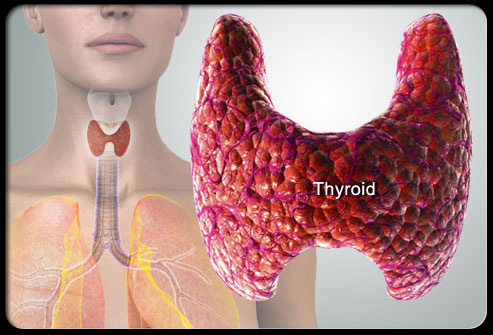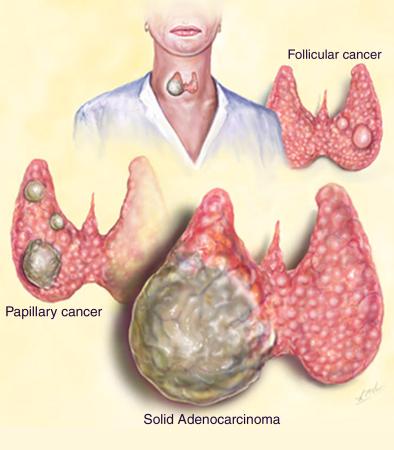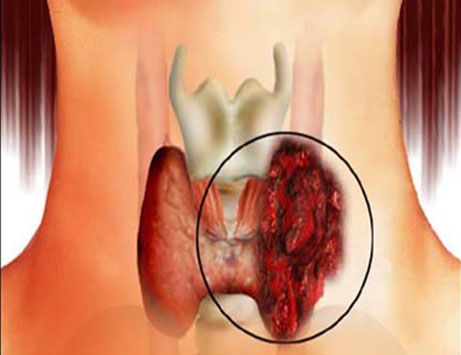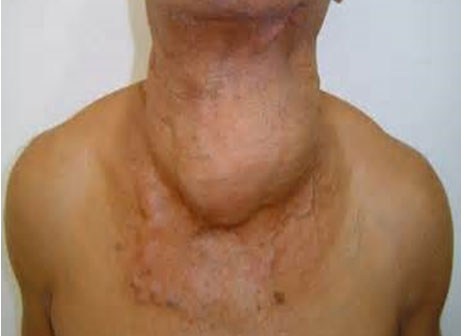Introduction
Thyroid glands is a butterfly shaped gland and is located at neck region. The glands have two lobes separated by a thin band of tissue called Isthmus. The glands help to regulate our body mechanisme. It produces Thyroid hormone when is needed. Two types of cell which produce the hormone are the Follicular cells and the C cells. Follicular cells produces thyroid hormone that regulate the heart beats, body temperature, and yields energy to human body. Meanwhile, C cells produce Calcitonin, a hormone that helps to control calcium level in blood. When the productions of these hormones are excessive in the body, it is known as hyperthyroidism while when it is too little it is known as hypothyroidism. Thyroid cancer begins when the cells in thyroid gland become abnormal, grow uncontrollably and form a malignant tumour of the thyroid. There are four types of thyroid cancer which are papillary, medulla tumour, follicular tumour and anaplastic tumour. If these thyroid cancer cells are not detected and early intervention for treatment is not carried out, it may spread to other parts of human body or organ through blood stream.
Sign and Symptom
Thyroid cancer in the early stage did not show any symptoms, however when the thyroid cancer cells started to develop, the symptoms can be easily felt and seen as a bump on the front of the neck.
Complication
When the thyroid cancer cells grow, the complications are very significant such as difficulty in swallowing, deglutition, talking, deep breathing, and burning pain or pain at neck or throat region.
Treatment
Thyroid cancer can be treated in several ways such as surgery approach, radiotherapy and chemotherapy. However, we will only discuss treatment via radiotherapy approach. What is radiotherapy? Radiotherapy is a method of treatment that uses an internal and external radiation rays to kill thyroid cancer cells..
In an external radiotherapy, a high energy X-rays is used to destroy cancer cells. It uses huge machine to produce high energy radiation focused at neck region or other parts of the body where the cancer cells has already spread out.
Before starting treatment with radiation, the doctor will identify the exact site of cancer. The actual dose needed will be determined by computer system. Correct treatment is needed to reduce the effects and to increase patient’s quality of life. With the new technology, target is only focused to cancer cells, therefore the risk of damaging the surrounding cells can be avoided. This methods are used both in Modulation Technology Consolidation Radiation Therapy (IMRT) and Image Guidance Radiation Therapy (IGRT).
For internal radiation treatment, patient will be given radioactive iodine which will dissolves in thyroid cells. Iodine 131 is one type of radioactive that can be obtained either in the form of liquid or capsule. The Half-life time for Iodine 131 is 8 days. During this period, patient’s body is being radiated. Radiation can be eliminate through normal body excretion. Therefore, patient is advised to drink plenty of water. For those patient who are given high dose will be quarantined in the nuclear medicine ward for 3-5 days and patients who received low dose are allowed to go home with the condition that they follow doctor’s advises related to radiation protection.
Before commencing radiation therapy with iodine 131, patients will be counselled on radiation protection. It is empirical important that patients know about this Radiation protection as it is closely related to personal care during admission and after return home within a period of time.
Prevention
Doctor will advise female patients who received Iodine 131 for not to be pregnant during treatment as this will affects the growth and development of their fetus. In addition, before receiving treatment, patient is advised not to eat seafood as it contains high iodine. Patients are also advised to stop taking drugs such as Thyroxin and traditional medicines.
Rehabilitation
Treatment of thyroid cancer with radiation only focused at the cancerous area only. However, patients may develop side effects after treatment such as nausea, vomiting, lost appetite, dry mouth, dry eye, sense of taste, odour change and even skin problems (skin pain, itching or pale) and pain at the area of thyroid cancer cells have spread to the neck or chest. In certain cases, fertility of male patient might deteriorate after being exposed to high dose of Iodine 131. Meanwhile female patients are allowed to get pregnant at least after one year of exposure. Patients are advised to follow closely all the doctor’s instruction to speed up recovery.
Support Organization/ reference
MAKNA (Majlis Kanser Negara) is a charity organization in the country that provides counselling and guidance regarding cancer. MAKNA helps to creates awareness and provide varieties of information’s from all related resources on current issues to public.
| Last Reviewed | : | 8 October 2014 |
| Writer / Translator | : | Dayang Masury bt. Ahmad Saib |
| Accreditor | : | Nik Mohamed Hazmi b. Nik Hussain |











